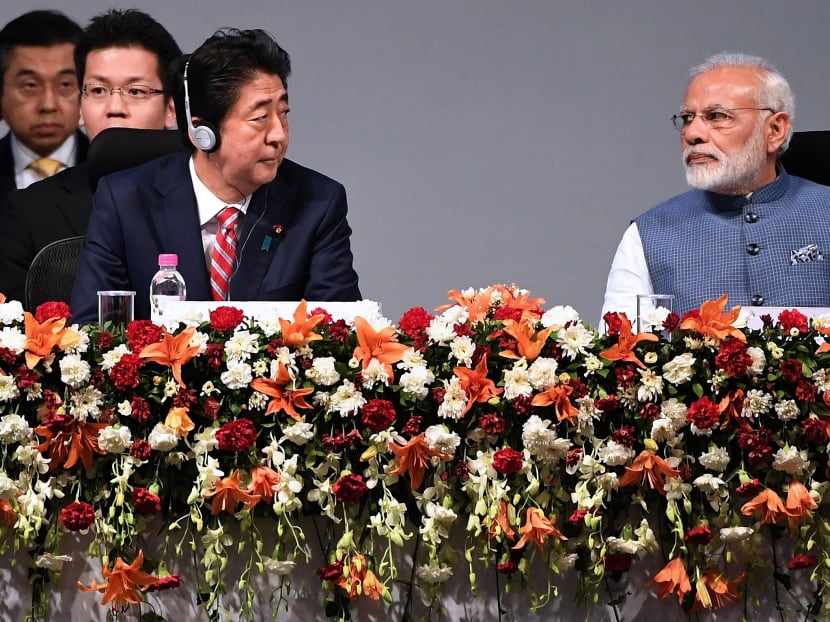Diplomatic initiative revived to counter China’s growing influence
NEW DELHI — Alongside the gladhanding, strutting and tweets from world leaders at two Asian summits over the past few days, one of the most important geopolitical developments came from a low-key meeting between civil servants from four countries.

Japanese Prime Minister Shinzo Abe (left) and Indian Prime Minister Narendra Modi during the India-Japan Business Plenary session in September. Japan, India, Australia, and the United States comprise the “quad”, a diplomatic initiative that was set up a decade ago to counterbalance China’s growing power in the region. Photo: AFP
NEW DELHI — Alongside the gladhanding, strutting and tweets from world leaders at two Asian summits over the past few days, one of the most important geopolitical developments came from a low-key meeting between civil servants from four countries.
Officials from the United States, Japan, Australia and India met on Sunday (Nov 12) on the sidelines of the Asean summit in Manila to restart the “quad”, a diplomatic initiative set up a decade ago to counterbalance China’s growing power in the region.
None of the four mentioned China in subsequent statements, but each touched on issues likely to make Beijing nervous.
They talked of the importance of the Indo-Pacific region being “free and open” and bound by a “rules-based order”. All except India called for freedom of navigation in the region, potentially challenging China’s territorial claims in the South China Sea.
“The very fact that this meeting happened is very important,” says Mr Harsh Pant, a fellow at the Observer Research Foundation, a New Delhi think-tank.
“It tells you that major powers have looked back at the last decade and made an assessment that whatever China has done has not been beneficial to the balance of power.”
The quad, short for Quadrilateral Security Dialogue, was conceived in 2007 but disbanded the following year after complaints from Beijing.
Those objections were heard loudest in New Delhi, which is traditionally wary of formal alliances, and Canberra, where the government hoped to dissuade China from acting aggressively in the region.
“Involving all four parties was seen as too provocative back then,” says Mr Dhruva Jaishankar, a fellow at the Brookings India research group. “So to do this on the sidelines of a major summit [now] is a significant break from the past.”
The break-up of the quad in 2008 was seen as a particular blow to Tokyo, which has long sought greater co-operation between the four democratic countries.
In an effort to overcome resistance from India and Australia, Japanese Prime Minister Shinzo Abe has targeted the leaders of both countries with his personal style of diplomacy.
This has proved successful particularly with India’s Narendra Modi, with the two leaders swapping repeated bilateral visits.
Despite this, India’s government has until recently been reluctant to co-operate with the three other nations.
This year, for example, New Delhi refused to let Australia join the Malabar naval exercise, held jointly with Japan and the US.
Foreign policy specialists say the mood has changed in Canberra and New Delhi because of a perception that seeking to appease China has not curtailed Beijing’s expansionist policies. They point especially to the way China has turned a number of reefs into de facto military bases in the South China Sea since 2012.
Mr John Hemmings, director of the Asia Studies Centre at the Henry Jackson Society, a foreign policy think-tank, sais: “We must ask ourselves: by avoiding collective security arrangements in 2008, did we persuade China to behave as a model citizen in the region?”
As well as reining in Beijing, observers say the creation of a formal alliance is designed to tie in Washington at a time when many US allies are unsure how reliable a partner Donald Trump’s administration will prove.
“This represents an attempt by Japan, Australia and India to keep the US engaged in the region at a time when there are concerns about America’s position following the election of Donald Trump,” says Mr Euan Graham, director at the Lowy Institute in Sydney.
Many in India were delighted by Mr Trump’s adoption of the phrase “Indo-Pacific” to describe the region, which they feel gives a formal acknowledgment of the role New Delhi would like to play.
So far, Beijing has not protested at initial steps towards the creation of a new regional alliance.
“There is no reason to believe it is targeting China,” Mr Zhang Jun, a senior official at the Chinese foreign ministry, said at the Asia Pacific Economic Cooperation Forum in Vietnam. “No matter what [Trump’s Indo-Pacific] strategy is, it should be open, inclusive and embody equality, mutual benefit and respect as opposed to serving the interests of a small group of countries.”
Yet some believe the greater threat to the quad is not from China, but the commitment shown by the unpredictable Mr Trump.
“Despite coining his regional policy approach the ‘Indo-Pacific strategy’ . . . Mr Trump largely avoided discussing the importance of promoting human rights and good governance in the region,” says Mr Paul Haenle, director of the Carnegie-Tsinghua Center in Beijing and a former White House adviser.
“Instead, he focused on respect for sovereignty and independence. This cannot have been the reassurance that Asian countries were seeking.” THE FINANCIAL TIMES






